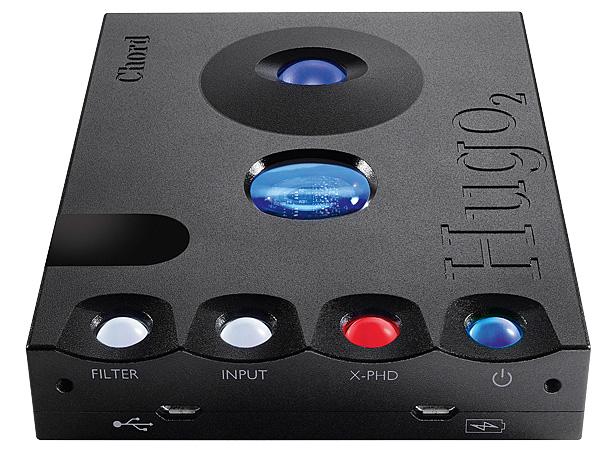Chord Hugo 2 headphone amp/DAC

 It can sometimes seem tricky to keep pace with the changes in the Chord Electronics range, but its Hugo 2 claims technical and spec advances over the original DAC/amp
It can sometimes seem tricky to keep pace with the changes in the Chord Electronics range, but its Hugo 2 claims technical and spec advances over the original DAC/amp
For a relatively small specialist audio brand – well, by the standards of some of the huge companies the industry seems determined to keep constructing these days – Chord Electronics has its bases covered in fairly spectacular fashion, from tiny pocket devices to hugely powerful amplification. What’s more, there’s little evidence of resting on laurels going on here. The company just keeps on adding new models to its range, from the Mojo/Poly portable DAC/amp/player/streamer combo to the newly announced Etude amplifier, said to use its ‘first fundamentally new topology’ since the company was founded some 30 years ago.
Dramatic Redesign
And it constantly reinvents its products, to the extent that it has been easy to get lost in all the variants of Qutes, Qutests, 2Qutes and QuteHDs, for example. However, the £1800 Hugo 2 reviewed here is a relatively simple prospect – it’s the updated version of the company’s first portable DAC/amp, launched back in 2014. The company says it has been ‘dramatically redesigned’, and features ‘flexible new features, plus next-generation technical and sonic performance’, with ‘all-new casework’ in black or silver anodised aluminium.

So what’s going on, not least to justify the Moore’s-law-defying 50% increase in price over the original Hugo – so-named, with its onboard battery power, to provide music wherever ‘you go’? Well, for a start the Hugo 2 looks different, its casework adorned with four extra illuminated ‘control spheres’ of the kind familiar from the little Mojo [HFN Jan ’16] and other more recent Chord products. The main volume control sphere of the original Hugo has been retained (albeit in a larger form), as has the transparent panel giving a view of the internal circuitry. Once again, the illumination changes colour to indicate the incoming sample rate, but now the product quite literally has more balls: they control power, input, filtering and crossfeed functions.
These control devices are top-mounted to allow scope for adding expansion modules to the USB ‘input end’ of the casework. Perhaps that hints at the future availability of a Poly-style player/streamer device? The micro USB input supports (driverless) portable devices, and there’s full HD compatibility with PCM-based formats up to 768kHz/32-bit as well as DSD512. A driver is offered for Windows OS(s). The original Hugo did 384kHz and DSD128 but the Hugo 2’s optical and coaxial digital ins are still capped-out at 192kHz and 384kHz, as before. A separate micro USB input is provided for charging.
There’s also an improved Bluetooth implementation, now with aptX capability and claiming extended range, while the outputs are on standard RCA phonos, plus 3.5mm and 6.35mm headphone sockets. The input and output labelling is now laser-ablated for greater clarity and durability.
Desktop Emphasis
The original Hugo had a rounded style, emphasising its pocketability, so if the more squared-off looks of the Hugo 2 suggest a greater emphasis on desktop audio applications as much as for ‘wherever you go’, that’s no coincidence.
Yes, there’s still that fast-charging internal battery, said to be good for 14 hours’ use, but the new model also comes with a comprehensive remote control handset. It’s more likely to be used in a static implementation, as your main means of controlling things, with the control spheres relegated for use only when on the move.
The remote even has a dimmer button, which may be handy for late night listening or simply when the exuberant illumination becomes just a bit too eye-catching. The IR sensor is in that ‘viewing window’ on the top of the Hugo 2, and if you want to take the device even further on from the ‘desktop audio’ idea, you can also switch its outputs to a fixed 3V line level, allowing it to be used as pure source into a conventional preamp or integrated amp.
The Hugo 2 has also gained some weight, up 50g to 450g, and the way the company describes it is interesting: the original Hugo was pitched as portable, but this one is ‘transportable’. Mind you, should you feel the need to ‘transport it’, there’s a leather case available for the Hugo 2, though it’ll cost you another £125.
Editor PM goes into detail about the WTA DAC technology used inside the Hugo 2 [see The WTA Filter sidebar], but suffice it to say here that it’s a more advanced version of the Rob Watts-designed upsampling/filtering and conversion deployed in the original Hugo. The development of this bespoke DAC technology is an ongoing process at Chord: already the forthcoming Hugo TT2 – the latest iteration of the ‘Table Top’ non-portable Hugo derivative [HFN Dec ’15] and due on sale later this year at just under £4000 – boasts more than double the processing power of the Hugo 2. The Hugo 2, meanwhile, offers twice the DSP horsepower of the original model and that was double that offered by the original QuteHD DAC [HFN Sep ’12], although Chord’s flagship DAVE DAC [HFN Apr ’16] still remains the ‘reference’.
![]() Clarity With Slam
Clarity With Slam
A product with capabilities as wide-ranging as this required extensive testing in a variety of set-ups. I found myself using the Hugo 2 on the end of my iPhone 8 Plus, and also with an Android tablet, my stripped-out Mac mini computer and Roon-equipped Intel NUC, as well as via coaxial digital from my Naim NDS. Headphones included the B&W P9 Signature [HFN Mar ’17], Focal Spirit Pro [HFN Dec ’15] and Oppo PM-1 [HFN Jul ’14]. The Hugo 2 was also connected at line level into my main system.

























































